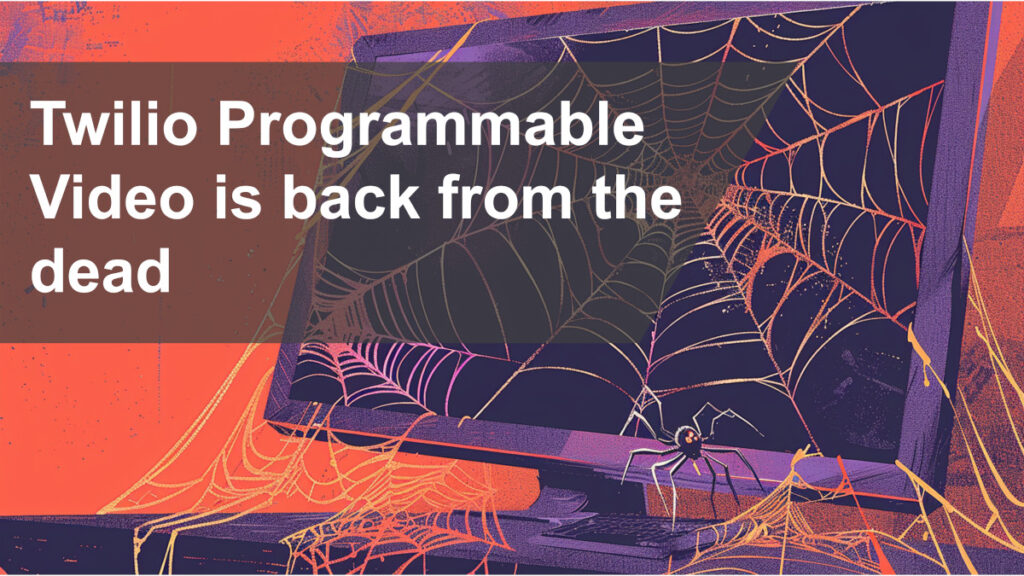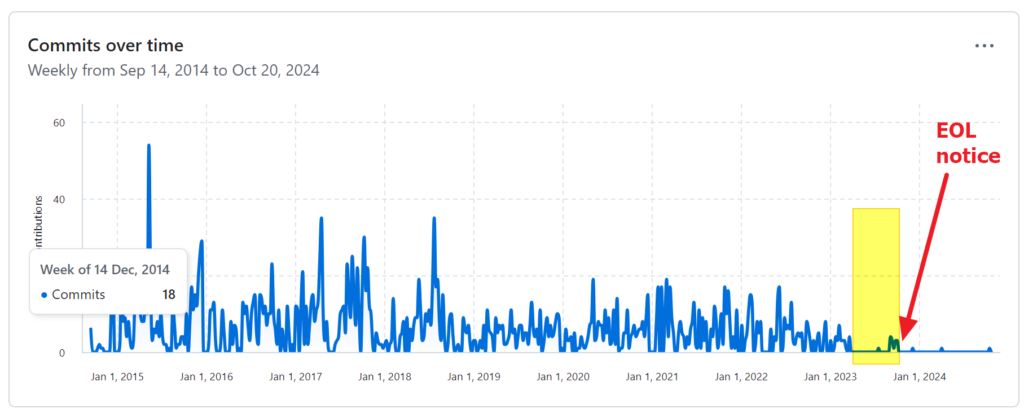Twilio Programmable Video is back. Twilio decided not to sunset this service. Here’s where their new focus lies and what it means to you and to the industry.

A year ago, Twilio announced sunsetting its Programmable Video service. Now, it is back from the dead, like a phoenix rising up from the ashes. Or is that going to be more like a dead walking zombie?
Here’s what I think happened and what it means – to CPaaS, Twilio and other vendors.
Twilio being central about CPaaS means they have a dedicated page of their own on my site – you can check it up here: Twilio
Table of contents
Zig: Twilio Programmable Video sunset

Let’s first look at two important aspects of the decision of Twilio to sunset their Twilio Programmable Video service. I did a couple of video recordings converting some of the visuals from my Video API report and placed them on YouTube (you should subscribe to my channel if you haven’t already).
The first one? A look at Twilio’s video services.
- Introducing 1:1 video
- Acquiring Kurento
- Introducing Group video
- Launching Video WebRTC Go (free service)
- Introducing Live
- Sunsetting Live
- Sunsetting Programmable Video
The second one? A look at how the market is going to figure this one out:
- Twilio customers will migrate to other Programmable Video solutions OR go to build their own
- Companies looking for a solution will be more likely now to build on their own instead of using Programmable Video (due to fear of that vendor sunsetting it like Twilio)
All in all, not good for the market.
Twilio Customers in the past year

To be frank, this started before the EOL announcement. If you look at the commits done to the Twilio Video SDK you see this picture:

Half a year prior to the announcement, the SDK got no commits whatsoever. And then? The official EOL came.
This last year has been tough on Twilio’s customers who use Programmable Video.
They had to migrate away from Twilio, with the need to do it by the end of 2024.
The time wasn’t long enough for many of the customers, and they likely complained to Twilio. The EOL (End Of Life) date moved to 2026, giving two more years for these customers.
The development work needed to switch and migrate away from Twilio might not have been huge, but it was not scheduled and came in as a critical requirement. In some cases, the customers didn’t have the engineering team in place for it, because external outsourcing vendors and freelancers originally developed the integration. In other cases, the migration required also dealing with mobile native applications, which is always more expensive and time consuming.
Once I had a vendor complain that they can’t replace the code in the appliances it deployed in a timespan of a year even if he wanted to – he works in a regulated industry and environment with native mobile applications.
Twilio set up their customers to a royal mess and a real headache here.
Zag: Twilio Programmable Video back from the dead

Then came the zag. Twilio decided to revert its decision and keep Twilio Programmable Video going. Here’s the statement/announcement from Twilio’s blog.
Here’s how they start it off:
“Today, we’re excited to announce that Twilio Video will remain as a product that we are committed to investing in and growing to best meet the needs of our customers. […]
Twilio Video will not be discontinued, and instead, we are investing in its development moving forward to continue to enhance customer engagement by enabling businesses to embed Video calling into their unique customer experiences.”
In their “why the change” section of the post, Twilio is trying to build a case for video (again). In it, they are making an effort to explain that they aren’t going to sunset video in the future, which is an important signal to potential new customers as well as existing ones. Their explanation revolves around the customer engagement use cases – this is important.
The “what to expect moving forward” section is the interesting part. It is built out of 4 bullets. Here’s what I think about them:
- Focused Innovation. Based on the explanation, Twilio will invest in customer engagement use cases. These are mainly 1:1 video calls
- New features and enhancements. These are likely to be focused around Segment and integrating with that part of Twilio. At least based on what they write (the bold words are my interpretation): “We will specifically focus on making it easier to seamlessly integrate Video calling into your customer engagement experiences as well as extracting and leveraging data to optimize your experiences and deliver actionable business insights”
- Customer and product support. Another way of saying that this is a real product and not just an under maintenance service
- Training and resources. Same as the previous point
Alli in all, Twilio is planning on focusing predominantly on 1:1 customer engagement use cases and connecting them to Segment. At least that’s my reading of things.
Sunk costs or a hidden opportunity for customers

What about Twilio Programmable Video customers?
They had a year to plan and move away from the service to something else. Many of them either finished their migration or close to that point.
Should they now revert back to using Twilio? Stick with the competition?
Those who are in the middle of migration – should they stick to Twilio or keep investing resources in migrating away from Twilio?
These customers spent time and money on moving away. Should they view that as sunk costs or as an opportunity?
From discussions with a few Twilio customers, it seems that the answers are varied. In some cases, what they’ve done is built an abstraction running on top of two vendors – Twilio and the new vendor they’re migrating to. This way, they can keep Twilio as a backup as long as Twilio runs the service.
Now? They have the option to pick and choose which of the two alternatives to use.
This works well for services that do 1:1 meetings. Less so for group meetings.
In a way, Twilio reverting back adds another layer of headache and decisions that customers now need to go through (again).
Twilio’s challenges ahead

This leads us to the challenges Twilio is about to face.
The 3 leading ones are:
- Dilution of customers’ trust. These back and forth decisions will have customers thinking of other alternatives before picking Twilio. Twilio will need to convince customers that they are the better choice. Going for data and Segment integration is likely the way for them to do it. By focusing on where they see their future and entwining video to it, they stand a chance of getting through to potential customers
- A wasted year. The market hasn’t been waiting for Twilio. Their competitors have continued investing in their Programmable Video offering while Twilio’s stagnated since well before the EOL announcement. Twilio will somehow have to make up for this
- Decimated engineering team. When Twilio announced the EOL it also let go of employees. Some of them from the Programmable Video team. The knowledge and knowhow they have at Twilio today about their own product is likely lower than it was a year ago. It will take time to ramp it back up
All 3 are solvable, but will take time, attention and commitment on behalf of Twilio.
Zoom: The biggest winner of all

The big winner this past year? Zoom.
Zoom had an SDK and a Programmable Video offering, but it was known and popularized for its UCaaS service. Twilio sunsetting Programmable Video while at the same time suggesting and sending customers to Zoom was a proof of quality from a third party in the space that Zoom enjoyed.
This cannot be taken back now. It rocketed the Zoom Video SDK to one of the alternatives that potential buyers now need to review and explain why they shouldn’t be trialing it.
All in all, a good thing for Zoom.
This change of heart by Twilio? Not going to affect Zoom.
What should you do

If you are already using Twilio and were migrating away –
- If you finished the migration and you are happy with the new vendor or your own infrastructure – then stay with the new solution
- If you still haven’t finished, then it depends
- If your service is 1:1 in nature, consider sticking with Twilio
- If your service is group meetings, I’d continue investing in an alternative solution. Twilio is unlikely to invest much in there in the coming year or two
- If you haven’t started yet, then check Twilio as an alternative if your meetings are 1:1 and you’re focused on customer engagement. Go elsewhere otherwise
There’s also always my Video API report to help you out (contact me for a discount on it or if you want some more specific consultation)
